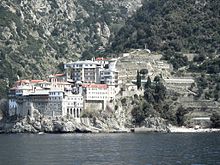필라스테레아
Filasterea| 필라스테레아 | |
|---|---|
 | |
| 캡스스포라 오우차자키 | |
| 과학적 분류 | |
| 도메인: | |
| (순위 미지정): | |
| (순위 미지정): | |
| (순위 미지정): | |
| 클래스: | 필라스테레아 Salchian-Tabrizi, 2008 |
| 패밀리와 속 | |
Philasterea는 Minioria와 Capsospora를 [1]포함하는 제안된 기초 필로조아 분지입니다.Choanoflagellatea와 Animals가 출현한 Choanozoa의 자매종이다.샬치안-타브리지 등이 2008년에 수십 개의 유전자를 가진 계통학 분석을 바탕으로 처음 제안했다.필라스테리아는 오피스토콘타 내의 메타조아와 초아노플라겔라타로 구성된 분지군의 자매군인 것으로 밝혀졌으며, 이 발견은 추가적인 더 많은 분류군이 풍부한 계통발생학적 [2][3][4]분석을 통해 더욱 입증되었다.
어원학
"나사"를 의미하는 라틴어 필룸과 "별"을 의미하는 그리스어 별에서, 그것은 모든 통합체에 의해 공유되는 주요 형태학적 특징을 나타낸다: 필로포디아로 알려진 길고 방사하는 세포 돌기로 덮인 단핵 세포체와 함께 작고 둥근 아메보이드.이러한 필로포디아는 기질 접착과 먹이 포획에 관여할 수 있다.
적용들
현재 2종류의 필라스테리아 문화가 있다.첫 번째 민물 달팽이에서 분리된 캡스스포라 오우차자키와 미니스티리아 비브랜스, 두 번째 해양 자유생활 세균성 세균성 세균성 세균성 세균성 세균성 균입니다.C. owczarzaki의 완전한 게놈 배열을 얻었으며 M. vibrans의 게놈 배열을 분석 중이다.비교 분석 결과 필라스테레아는 동물의 단세포 조상의 유전적 레퍼토리를 밝혀내고 메타조아의 기원에 대한 통찰력을 제공하는 핵심 요소인 것으로 나타났다.해양 환경에서 18S 리보솜 RNA의 메타코드 분석은 다른 필라스테리아 [6][7]대표자들을 회복하는 데 실패했으며, 이는 이 분지가 자연 생태계에 특별히 풍부하지 않을 수 있음을 시사한다.
분류법
- 클래스 Filasterea Shalchian-Tabrizi et al. 2008[8][9][4]
- 1997년 장관령 카발리에 스미스[10][11]
- 가족부 장관 Cavalier-Smith[1] 2008
- 1993년 패터슨 외속 장관
- 미니스타리아 마리솔라 패터슨 외 연구진 1993
- 미니스티리아 비브란스 1997년 통
- 1993년 패터슨 외속 장관
- 패밀리 캡스포르과 Cavalier-Smith[1] 2008
- 가족부 장관 Cavalier-Smith[1] 2008
- 1997년 장관령 카발리에 스미스[10][11]
| 오피스토콘타 |
| ||||||||||||||||||||||||||||||||||||||||||||||||||||||||||||||||||
몇몇 연구에서 Capsasspora는 Minoritia보다 Choanozoa와 [12]더 밀접한 관련이 있는 것으로 밝혀졌다.
레퍼런스
- ^ a b c Shalchian-Tabrizi K, Minge MA, Espelund M, et al. (7 May 2008). Aramayo R (ed.). "Multigene phylogeny of choanozoa and the origin of animals". PLOS ONE. 3 (5): e2098. Bibcode:2008PLoSO...3.2098S. doi:10.1371/journal.pone.0002098. PMC 2346548. PMID 18461162.
- ^ Torruella, Guifré; Derelle, Romain; Paps, Jordi; Lang, B. Franz; Roger, Andrew J.; Shalchian-Tabrizi, Kamran; Ruiz-Trillo, Iñaki (February 2012). "Phylogenetic relationships within the Opisthokonta based on phylogenomic analyses of conserved single-copy protein domains". Molecular Biology and Evolution. 29 (2): 531–544. doi:10.1093/molbev/msr185. ISSN 1537-1719. PMC 3350318. PMID 21771718.
- ^ Torruella, Guifré; de Mendoza, Alex; Grau-Bové, Xavier; Antó, Meritxell; Chaplin, Mark A.; del Campo, Javier; Eme, Laura; Pérez-Cordón, Gregorio; Whipps, Christopher M. (2015-09-21). "Phylogenomics Reveals Convergent Evolution of Lifestyles in Close Relatives of Animals and Fungi". Current Biology. 25 (18): 2404–2410. doi:10.1016/j.cub.2015.07.053. ISSN 1879-0445. PMID 26365255.
- ^ a b c d e Hehenberger, Elisabeth; Tikhonenkov, Denis V.; Kolisko, Martin; Campo, Javier del; Esaulov, Anton S.; Mylnikov, Alexander P.; Keeling, Patrick J. (2017). "Novel Predators Reshape Holozoan Phylogeny and Reveal the Presence of a Two-Component Signaling System in the Ancestor of Animals". Current Biology. 27 (13): 2043–2050.e6. doi:10.1016/j.cub.2017.06.006. PMID 28648822.
- ^ Suga, Hiroshi; Chen, Zehua; Mendoza, Alex de; Sebé-Pedrós, Arnau; Brown, Matthew W.; Kramer, Eric; Carr, Martin; Kerner, Pierre; Vervoort, Michel (2013-08-14). "The Capsaspora genome reveals a complex unicellular prehistory of animals". Nature Communications. 4: ncomms3325. Bibcode:2013NatCo...4.2325S. doi:10.1038/ncomms3325. PMC 3753549. PMID 23942320.
- ^ del Campo, Javier; Ruiz-Trillo, Iñaki (2013-04-01). "Environmental Survey Meta-analysis Reveals Hidden Diversity among Unicellular Opisthokonts". Molecular Biology and Evolution. 30 (4): 802–805. doi:10.1093/molbev/mst006. ISSN 0737-4038. PMC 3603316. PMID 23329685.
- ^ Del Campo, Javier; Mallo, Diego; Massana, Ramon; de Vargas, Colomban; Richards, Thomas A.; Ruiz-Trillo, Iñaki (September 2015). "Diversity and distribution of unicellular opisthokonts along the European coast analysed using high-throughput sequencing". Environmental Microbiology. 17 (9): 3195–3207. doi:10.1111/1462-2920.12759. ISSN 1462-2920. PMC 4500835. PMID 25556908.
- ^ Adl; et al. (28 September 2012), "The Revised Classification of Eukaryotes" (PDF), Journal of Eukaryotic Microbiology, 59 (5): 429–493, doi:10.1111/j.1550-7408.2012.00644.x, PMC 3483872, PMID 23020233, archived from the original (PDF) on 2013-12-16
- ^ Silar, Philippe (2016), "Protistes Eucaryotes : Origine, Evolution et Biologie des Microbes Eucaryotes", HAL Archives-ouvertes: 1–462
- ^ Ondřej Zicha (1999), "Ministeria", BioLib.cz, retrieved 2016-04-21
- ^ Ruggiero; et al. (29 April 2015), "A Higher Level Classification of All Living Organisms", PLOS ONE, 10 (4): e0119248, Bibcode:2015PLoSO..1019248R, doi:10.1371/journal.pone.0119248, PMC 4418965, PMID 25923521
- ^ Reynolds, Nicole K.; Smith, Matthew E.; Tretter, Eric D.; Gause, Justin; Heeney, Dustin; Cafaro, Matías J.; Smith, James F.; Novak, Stephen J.; Bourland, William A. (2017). "Resolving relationships at the animal-fungal divergence: A molecular phylogenetic study of the protist trichomycetes (Ichthyosporea, Eccrinida)". Molecular Phylogenetics and Evolution. 109: 447–464. doi:10.1016/j.ympev.2017.02.007. ISSN 1055-7903. PMID 28219758.




